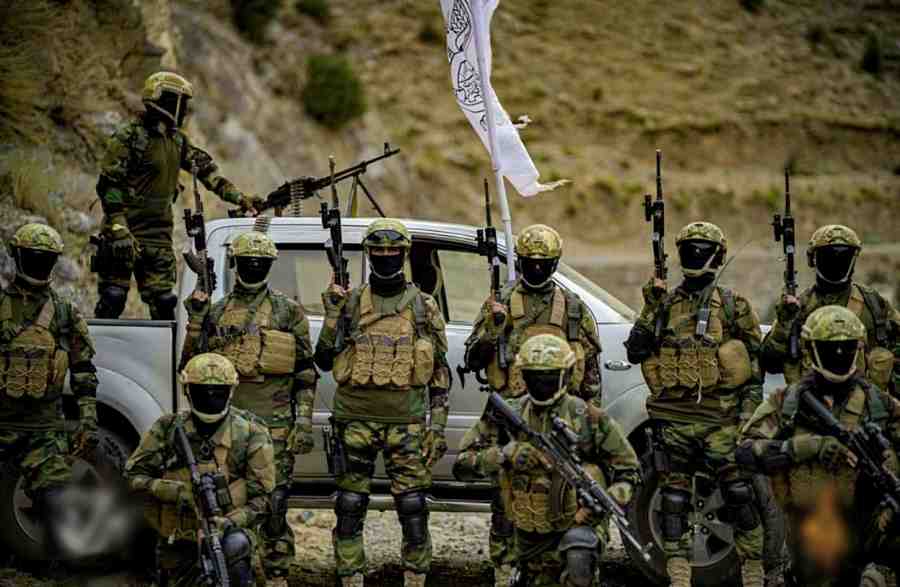![]() Members of the Taliban Badri 313 military unit.
Members of the Taliban Badri 313 military unit.
Sun 04 June 2023:
Iran expects Taliban to fulfill its promises in practice, while also wondering about stance of international community, regional actors
In three questions, Mehmet Koc discusses the dispute between Iran and the Taliban with possible scenarios for the region.
What is the dispute between Iran and the Taliban?
After the US ended its 20-year occupation of Afghanistan in August 2021, the Taliban regained control of the country.
Unlike the period from 1995 to 2001 when the Taliban ruled Afghanistan, Iran pursued a more positive policy toward the Taliban and initiated contact with the group before the US withdrawal.
During the 1990s, the Taliban executed nine people, including eight diplomats and one journalist, at Iran’s consulate in the Afghan city of Mazar-i Sharif.
The incident escalated tensions between the Taliban and Iran, almost pushing them to the brink of war.
However, due to the rapprochement between the Taliban and Iran during the US occupation, some Taliban officials visited Iran. Taliban officials were killed in US bombings on their return from Iran visits.
Relations between Iran and the Taliban led to a convergence in their anti-US sentiment, resulting in a softening of their approaches and leading them to cooperation.
AFGHANISTAN AND IRAN EXCHANGE HEAVY CROSS-BORDER FIRE OVER WATER DISPUTES
So, when the Taliban took control of the country, public opinion in Iran was divided. The establishment displayed a positive stance toward the Taliban, paving the way for a new diplomatic chapter between the two sides.
During this period, Iran minimized its military, political and diplomatic support to the Hazara Shiite minority group, whom it supported based on sectarian affiliation, and to Tajiks, with whom it had close contact based on ethnic affiliation, in exchange for the Taliban’s tolerated policies toward these groups.
The diplomatic ties between Tehran and the Taliban were improved but the relationship between the two sides is based on a cautious and realistic approach rather than pure optimism.
Iran expects the Taliban to fulfill its promises in practice, while also wondering about the stance of the international community and regional actors.
TALIBAN SUPREME LEADER AKHUNZADA, QATARI PM TALKS HELD IN KABUL
Therefore, Iran adopts a wait-and-see approach instead of immediately officially recognizing the Taliban.
Since the Taliban took power, there have been 12 instances of border tensions between Iran and Afghanistan.
However, the incidents were kept under control through negotiations.
In addition to tensions at the border, there have been occasional political controversies on diplomatic levels regarding the long-standing water crisis, smuggling and the return of millions of Afghan refugees to Iran.
Iranian President Ebrahim Raisi recently made a statement regarding the insufficient allocation of water shares from the Helmand River, which originates in Afghanistan and flows into Iran.
The Taliban responded that it could not provide more water because of a drought, which led to clashes on the border.
TALIBAN COMMANDER THREATENS TO CONQUER IRAN AMID BORDER CLASHES OVER ONGOING WATER DISPUTE
Does the Taliban have the military power to compete with countries in the region?
The military power of the Taliban derives not only from its military equipment and capacity but also from its experience and methods in unconventional warfare.
The best example of this is the war strategy developed by the Houthis in Yemen against Saudi Arabia and its allies.
Despite having limited military and weapon capabilities, the war strategy has proven to be highly disruptive — inflicting significant material and psychological damage on the opposing side.
Therefore, it is not feasible for the Taliban to engage in conventional warfare with a country like Iran, especially considering the $80 billion worth of military equipment left behind by the US during its withdrawal.
However, as a result of the asymmetric warfare the Taliban conducted against the US for more than 20 years, it has gained the confidence to assert that it will not remain indifferent if its internal affairs are interfered with.
While the Taliban said it will not pose a threat to neighboring countries as long as they do not meddle in its internal affairs, it prompts neighboring countries to act cautiously.
Despite the Taliban stating it will not pose any threat to neighboring countries as long as they do not interfere in its internal affairs, Iran, Pakistan, Tajikistan, Uzbekistan, and Turkmenistan have increased security measures on their borders with Afghanistan.
TALIBAN LEADER: “NOT A SINGLE LAW OF INFIDELITY WILL FIND A PLACE IN AFGHANISTAN”
What are the possible scenarios for the region?
In addition to territorial claims against Pakistan, the Taliban exerts pressure on Islamabad through its ethnic ties with millions of Pashtuns in Pakistan.
There is also the possibility of potential effects and support for the strengthening of radical groups in Central Asia.
The water dispute with Iran in addition to smuggling, ethnic and sectarian identity conflicts, and the issue of millions of regular and irregular Afghan refugees, the potential for conflicts, albeit localized, creates a constant atmosphere of vigilance prevailing in the region.
Finding a permanent solution to these problems with the Taliban, who lack experience in running the state, does not seem feasible in the short term to create a lasting environment of security, stability, and peace.
TALIBAN REJECTS RUSSIA’S CLAIMS OF ARMED GROUPS IN AFGHANISTAN POSING REGIONAL THREAT
It is still uncertain how long it will take for the international community to recognize the Taliban.
China, Russia, the US, EU countries and neighboring nations to Afghanistan are currently testing their relationships with the Taliban.
It seems that the current situation will continue until the Taliban can prove its ability to fulfill the requirements and responsibilities of being a contemporary state.
Therefore, Iran is also striving to manage potential problems and localized conflicts with the Taliban without engaging in a war, taking into account these conditions.
Moreover, considering the economic pressure caused by US sanctions and the escalating economic crisis triggering new political and social protests within the country, Iran is attempting to repair its troubled relationships with neighboring countries while avoiding confrontation with the Taliban.
On the other hand, both sides are under pressure from the US and subject to its sanctions, causing them to provide support to each other and show that they can control the emerging localized conflicts and crises.
The statements, views and opinions expressed in this column are solely those of the author and do not necessarily represent those of Independent Press.
This Article Originally Published in Anadolu Agency Click Here
______________________________________________________________
FOLLOW INDEPENDENT PRESS:
TWITTER (CLICK HERE)
https://twitter.com/IpIndependent
FACEBOOK (CLICK HERE)
https://web.facebook.com/ipindependent
Think your friends would be interested? Share this story!





